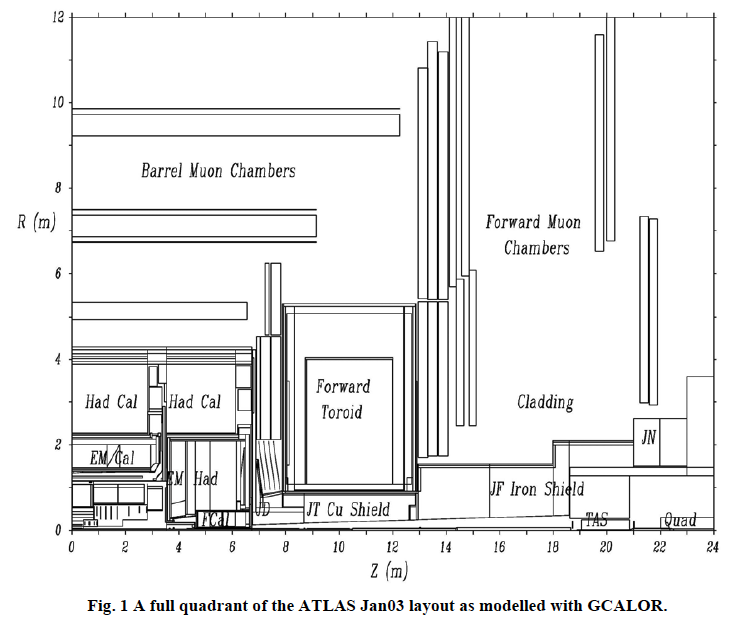The intense beams and large cross sections at the LHC give rise to high flux of background throughout the ATLAS detector cavern. This background, composed mainly of low energy neutrons and photons, can cause radiation damage to detector elements and front-end electronics. The induced hits increase detector occupancy. It is important to properly simulate this background so we can understand the sources and attempt to shield them. Cavern background is also crucial for sLHC upgrade.
ATLAS carried out such a calculation several years ago. It used the detector and shielding geometries known at that time. This calculation needs to be updated now to reflect the geometries as expected for the start-up of beams in late 2009. SLAC is spearheading this effort.
Tool
It is generally accepted that the physics modeling in the FLUKA package gives the best agreement with data for the low-energy neutrons and photons that are important here. On the other hand, ATLAS has little expertise with FLUKA but has much experience with Geant4, which is regarded as having a more flexible geometry definition. We therefore decided to use FLUGG, which couples Geant4 geometry with FLUKA physics.
Validation
The earlier studies made by the ATLAS Radiation Background Task Force (RBTF) have been reported in ATL-GEN-2005-001. The first figure shows a quadrant of the layout, for z <= 24 m and r <= 12 m, as modeled in the report.
The next figure is the calculated neutron flux.
We used the same geometry, materials, etc as in this report, and compare our FLUGG results with the G3/GCALOR results from the Task Force. The agreement is good.
Start-Up for 2009-2010
There is already a very detailed Geant4 description of the ATLAS detector used in physics event simulation; however, it is far too complicated for this application. Instead, we will update the validation geometry to be consistent with the full ATLAS description, concentrating on those regions that affect background the most, e.g.
- Beam line and shielding
- Gap between barrel and toroid
- Cavern outline
We will also add the large missing elements such as
- Barrel toroid
Some simplifications will be made, especially detector internal geometries which are important for detector response but not for this application. It is important to maintain the proper isotopic composition of materials as neutron cross sections are sensitive.
We will calculate the background for each of these changes individually in order to understand their effects.
Expected radiation levels and counting rates will be compared with data after beam turn-on in late 2009. Differences have to be traced back to possible inaccuracies in the modeling.
sLHC Studies
ATLAS will be replacing the Inner Detector tracker for Super LHC. It is expected to be an all-Silicon detector with pixels and strips. We believe additional shielding is needed for the FCAL. It is also expected to replace part of the muon spectrometer detectors. The scope of the muon upgrade has great uncertainty at this time. It can be as little as replacing the endcap detectors at small radii, or it can be replacing all muon detectors, depending on the background level. One of the goals of the cavern background calculation is to provide a more reliable prediction.
Status
As of May 2009, the validation geometry and materials used by the Radiation Trask Force have been implemented. First results from FLUGG are available. The next step is to define the outputs necessary for comparison with the Task Force results.
Work has started on the 2009 start-up geometry.
Meetings and Material
Agendas can be found at http://indico.cern.ch/categoryDisplay.py?categId=225 with schedules and connection details.

